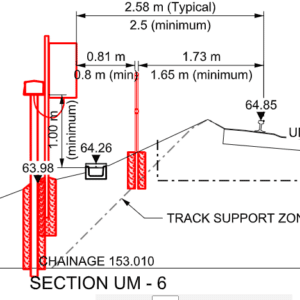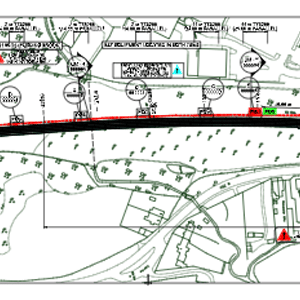Thingley – Christian Malford Resilience Scheme
The project
This scheme from Christian Malford to Thingley in Wiltshire increases the resilience of the power feed from Thingley ATFS on to the overhead line system which is part of The Greater West (TGW) programme. The scheme comprises two low-level cabled auto-transformer feeders (ATF) and two low-level cabled overhead contact system (OCS) feeders to terminate at new switching structures which interface with the existing overhead line equipment (OLE). The HV cable element is approximately 4.2 km along track and comprises a total of approx. 8.4km of cable containment routes and approx. 17.4km of cabling.
The challenge
To design a new low-level HV feeder route between the existing end of electrification at Christian Malford and the feeder station at Thingley Junction. This required interfacing the designed route with existing and proposed infrastructure, including listed structures, such as Brunel’s Chippenham Viaduct, and through pinch points such as Chippenham Station.
The solution
Enable Design (formerly known as Equate Design) produced a fully integrated 3-D design model – considering the requirements of the client, of interfacing projects and of external stakeholders – and coordinated the designs of other disciplines, such as electrical design. We managed the NR assurance process, including the Interdisciplinary Design Check/Review meetings. Enable also provided the project’s Contractors Engineering Manager (CEM) and Contractors Responsible Engineer (CRE – Design).
The Team
- Project Manager
- Engineering Manager
- Responsible Engineers
- Survey Engineers
- Civil Engineers
The deliverables
- Undertake the civils design for construction, testing and pre-commissioning of new feeder cables and cable containment
- Undertake all designer responsibilities under Construction (Design and Management) (CDM) Regulations 2015
- Design for installation of four new feeder cables: NR/PS/ELP/00008 25/44kV Graphite Covered MDPE Cables, 25/44kV 400mm2 Cu, XLPE insulated and83mm2 Cu wire screen. The cables run from Thingley ATFS substation to the limit of electrification at Christian Malford
- UTX, pinch point and through platform duct route designs
- Designs over listed structures
- Design for modification, and reuse, of existing cable containment routing, where suitable, along with new routing required within the Thingley Junction Substation compound and for the full extent of the proposed HV cable feeder installations.
- All works associated with the surveys required for the cable route design, including managing integration with existing and future assets, i.e. distribution substations, OLE structures, signalling and telecoms equipment; civil design works, including embankment works to facilitate routeing of HV cable, in accordance with NR/L2/CIV/003– Engineering Assurance of Building and Civil Engineering Works
- Design assurance deliverables;
- F001 – Approval in Principle
- F002 – Statement of Design Intent
- F003 – Certificate of Design and Check
- CAD deliverables
-
- Computer Aided Design drawings design in accordance with NR/L2/INI/EDT/CP0091 Specification for Computer Aided Design and in accordance with 118049-INF-PRO-MPM-000028 CAD Manual.
- Surveys and outputs produced in Snakegrid in line with W&W IMS 866.
- All Computer Aided Design data integrated within Network Rail’s ProjectWise system in line with GWC91002-NWR-WRK-DCM-000001 – Information Management
- Geospatially accurate 3D Civil/Structural Design CAD model files
- 2D civil and structural design CAD drawing layouts derived as an output of the 3D civil/structural design CAD model
- Other deliverables
- Strategy development & approval
- Survey report & review of existing services (inc. buried services)
- Ground investigation & report
- Cable route risk assessment
- Ground and structures investigation proposals
- Access strategy document
- Pinch point design surveys
- Building Information Modelling (BIM) management plan
- Design management plan
- Ecological survey
Gallery


Find out how we can help you
If we can help you in any way, please do get in touch. In order that we can assist you efficiently, please click on the link below. Alternatively, you can call us on 020 4566 9616.
Get in Touch